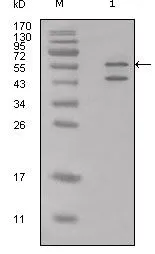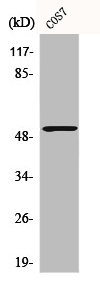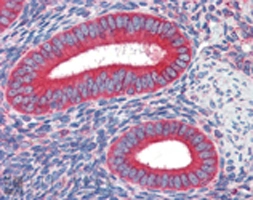
Immunohistochemistry analysis of human uterus tissue stained with Calreticulin, mAb (FMC 75) at 10microg/ml.
Calreticulin antibody [FMC 75]
GTX42683
ApplicationsFlow Cytometry, ImmunoFluorescence, Western Blot, ELISA, ImmunoCytoChemistry, ImmunoHistoChemistry
Product group Antibodies
TargetCALR
Overview
- SupplierGeneTex
- Product NameCalreticulin antibody [FMC 75]
- Delivery Days Customer9
- Application Supplier NoteRecommended dilutions: FACS: 1/100. ICC: Use at an assay dependent dilution. IHC: Use at a concentration of 2 microg/ml. IP: Use at a concentration of 12.5 microg/ml. WB: Use at a concentration of 0.5 microg/ml. Predicted molecular weight: 48 kDa. Not yet tested in other applications. Optimal dilutions/concentrations should be determined by the end user.
- ApplicationsFlow Cytometry, ImmunoFluorescence, Western Blot, ELISA, ImmunoCytoChemistry, ImmunoHistoChemistry
- CertificationResearch Use Only
- ClonalityMonoclonal
- Clone IDFMC 75
- Concentration1 mg/ml
- ConjugateUnconjugated
- Gene ID811
- Target nameCALR
- Target descriptioncalreticulin
- Target synonymsCALR1, CRT, HEL-S-99n, RO, SSA, cC1qR, calreticulin, CRP55, ERp60, HACBP, Sicca syndrome antigen A (autoantigen Ro; calreticulin), calregulin, endoplasmic reticulum resident protein 60, epididymis secretory sperm binding protein Li 99n, grp60
- HostMouse
- IsotypeIgG1
- Protein IDP27797
- Protein NameCalreticulin
- Scientific DescriptionCalreticulin is a multifunctional protein that acts as a major Ca(2+)-binding (storage) protein in the lumen of the endoplasmic reticulum. It is also found in the nucleus, suggesting that it may have a role in transcription regulation. Calreticulin binds to the synthetic peptide KLGFFKR, which is almost identical to an amino acid sequence in the DNA-binding domain of the superfamily of nuclear receptors. Calreticulin binds to antibodies in certain sera of systemic lupus and Sjogren patients which contain anti-Ro/SSA antibodies, it is highly conserved among species, and it is located in the endoplasmic and sarcoplasmic reticulum where it may bind calcium. The amino terminus of calreticulin interacts with the DNA-binding domain of the glucocorticoid receptor and prevents the receptor from binding to its specific glucocorticoid response element. Calreticulin can inhibit the binding of androgen receptor to its hormone-responsive DNA element and can inhibit androgen receptor and retinoic acid receptor transcriptional activities in vivo, as well as retinoic acid-induced neuronal differentiation. Thus, calreticulin can act as an important modulator of the regulation of gene transcription by nuclear hormone receptors. Systemic lupus erythematosus is associated with increased autoantibody titers against calreticulin but calreticulin is not a Ro/SS-A antigen. Earlier papers referred to calreticulin as an Ro/SS-A antigen but this was later disproven. Increased autoantibody titer against human calreticulin is found in infants with complete congenital heart block of both the IgG and IgM classes. [provided by RefSeq, Jul 2008]
- Storage Instruction-20°C or -80°C,2°C to 8°C
- UNSPSC12352203
References
- The novel estrogen-induced gene EIG121 regulates autophagy and promotes cell survival under stress. Deng L et al., 2010, Cell Death DisRead more

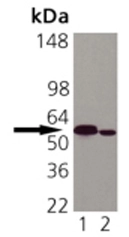
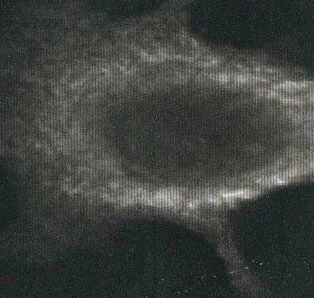
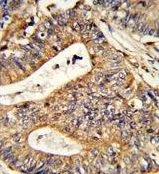
![ICC/IF analysis of SKBR-3 (left) and A549 (right) cells using GTX83089 Calreticulin antibody [1G6A7]. Green : Calreticulin Blue: DRAQ5 fluorescent DNA dye Red: Actin filaments](https://www.genetex.com/upload/website/prouct_img/normal/GTX83089/GTX83089_20170912_ICCIF_1_w_23061322_651.webp)
